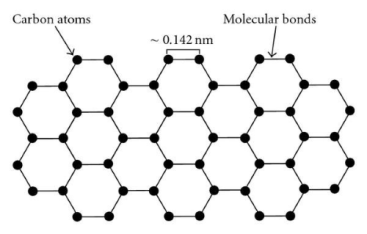Do you have any questions? Email Us
[email protected]

In the world of advanced materials, hexagonal boron nitride (hBN) and graphene have emerged as two groundbreaking contenders. Both materials possess unique properties and have the potential to revolutionize various industries. While graphene has garnered significant attention and acclaim for its exceptional properties, hexagonal boron nitride, often referred to as the "white graphene," is gaining recognition for its own set of remarkable characteristics. In this article, we will explore the battle between hBN and graphene, comparing their properties, applications, and potential impacts on different sectors.
Graphene is a two-dimensional carbon allotrope containing a single layer of carbon atoms set in a hexagonal lattice. It is renowned for its exceptional strength, high electrical conductivity, and thermal conductivity. Graphene's unique structure and properties have made it a sought-after material in fields such as electronics, energy storage, and composite materials.
 [1]
[1]
Figure 1. Graphene Structure
On the other hand, hexagonal boron nitride is a compound composed of equal parts boron and nitrogen atoms. It has a similar hexagonal lattice structure to graphene, leading to its nickname as "white graphene." The atomic structure of hBN gives it excellent thermal stability, high electrical insulation, and superior thermal conductivity, making it a versatile material in applications requiring high-temperature performance, electrical insulation, and thermal management.
Figure 2. hBN Structure
Although hBN and graphene are both two-dimensional materials with similar honeycomb atomic structures, they have a variety of different properties.
Graphene is renowned for its exceptional electrical conductivity. It is a zero-bandgap material, meaning it has excellent electrical conductivity and behaves like a semimetal or a zero-gap semiconductor, so it is ideal for use in electronic devices, sensors, and conductive coatings. Graphene's electrical properties have the potential to revolutionize the electronics industry, enabling faster and more efficient devices.
hBN, on the other hand, is an excellent electrical insulator. Its wide bandgap and low electron mobility make it an ideal material for electrical insulation and isolation. Boron nitride's electrical properties are particularly advantageous in high-voltage applications, where electrical insulation is crucial to prevent short circuits and ensure safety.
When it comes to thermal properties, both boron nitride and graphene excel in their own ways. Graphene possesses high thermal conductivity, allowing it to efficiently conduct heat. This property renders it suitable for thermal management in electronic devices, heat sinks, and other applications where efficient heat dissipation is crucial.
hBN, on the other hand, exhibits even higher thermal conductivity than graphene. Its ability to transfer heat efficiently makes it an excellent choice for thermal management in high-temperature environments, such as aerospace and power electronics. Boron nitride's thermal stability at extreme temperatures further enhances its suitability for applications requiring effective heat dissipation.
l Mechanical properties: Graphene is the strongest material known to date with exceptional mechanical properties, including high tensile strength, stiffness, and flexibility. While hBN is also mechanically strong but not as strong as graphene. Yet, it has good resistance to thermal and mechanical stresses.
l Optical properties: Graphene has unique optical properties and exhibits remarkable transparency and absorption characteristics over a wide electromagnetic spectrum, from ultraviolet to infrared. While hBN is transparent and has a wide bandgap. It is an excellent insulator for optics and photonics applications.
Graphene's properties have led to its application in various fields. It has been explored in electronics, energy storage, composite materials, sensors, and biomedical applications. Graphene's potential impact is far-reaching, with ongoing research and development aimed at unlocking its full potential.
Hexagonal boron nitride's exceptional properties have also found applications in diverse industries. Its high-temperature stability makes it suitable for use in thermal management systems, ceramic composites, and protective coatings. hBN's electrical insulation features are valuable in high-voltage applications, electrical devices, and insulating coatings. Its lubricity and low friction coefficient make it useful in applications such as lubricants, mold release agents, and coatings for reducing friction and wear.
You can refer to the Table 1. For a concise comparison of hBN and Graphene.
Table 1. Hexagonal Boron Nitride vs. Graphene
|
Hexagonal Boron Nitride (hBN) |
Graphene |
|
|
Electrical Properties |
Excellent electrical insulator; Wide bandgap and low electron mobility; Ideal for electrical insulation and isolation. |
Exceptional electrical conductivity; Zero-bandgap material; Ideal for electronic devices, sensors, and conductive coatings; Potential to revolutionize the electronics industry. |
|
Thermal Features |
High thermal conductivity; Suitable for thermal management in electronic devices and heat sinks. |
High thermal conductivity Suitable for thermal management in high-temperature environments; Enhanced heat dissipation due to thermal stability. |
|
Other Characteristics |
Mechanically strong with good resistance to thermal and mechanical stresses; Transparent and wide bandgap; Useful in optics and photonics applications. |
Strongest material known to date with exceptional mechanical properties; Unique optical properties with remarkable transparency and absorption characteristics. |
|
Applications |
Thermal management systems, ceramic composites, and protective coatings; High-voltage applications, electrical devices, and insulating coatings; Lubricants, mold release agents, and coatings for reducing friction and wear. |
Electronics, energy storage, composite materials, sensors, and biomedical applications; |
Related reading: Boron Nitride Overview: Properties, Production, and Uses
In short, hexagonal boron nitride and graphene are two revolutionary materials with distinct properties and potential applications. While graphene has gained significant attention for its exceptional electrical and thermal conductivity, hexagonal boron nitride brings its own set of advantages, such as thermal stability, electrical insulation, and high-temperature performance. Rather than pitting these materials against each other, the focus should be on exploring their synergies and collaborative potential. By combining the exceptional features of HBN and graphene, researchers can unlock new frontiers in material science and drive innovation across various industries.
Advanced Ceramic Materials (ACM) provides boron nitride products of different sizes and types. Customized hBN components are also welcome. For more information, please visit our homepage.
Further Reading: Hexagonal Boron Nitride VS. Cubic Boron Nitride